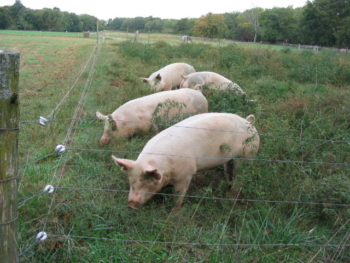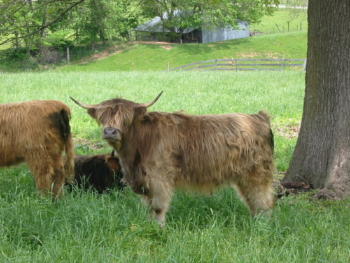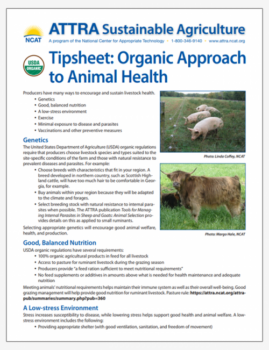Tipsheet: Organic Approach to Animal Health
By Linda Coffey, NCAT Agriculture Specialist
Producers have many ways to encourage and sustain livestock health.
- Genetics
- Good, balanced nutrition
- A low-stress environment
- Exercise
- Minimal exposure to disease and parasites
- Vaccinations and other preventive measures

Pigs. Photo: Linda Coffey, NCAT
Genetics
The U.S. Department of Agriculture (USDA) organic regulations require that producers choose livestock species and types suited to the site-specific conditions of the farm and those with natural resistance to prevalent diseases and parasites. For example:
- Choose breeds with characteristics that fit in your region. A breed developed in northern country, such as Scottish Highland cattle, will have too much hair to be comfortable in Georgia, for example.
- Buy animals within your region because they will be adapted to the climate and forages.
- Select breeding stock with natural resistance to internal parasites when possible. The ATTRA publication Tools for Managing Internal Parasites in Sheep and Goats: Animal Selection provides details on this as applied to small ruminants.
Selecting appropriate genetics will encourage good animal welfare, health, and production.
Good, Balanced Nutrition
USDA organic regulations have several requirements:
- 100% organic agricultural products in feed for all livestock
- Access to pasture for ruminant livestock during the grazing season
- Producers provide “a feed ration sufficient to meet nutritional requirements”
- No feed supplements or additives in amounts above what is needed for health maintenance and adequate nutrition
Meeting animals’ nutritional requirements helps maintain their immune system as well as their overall well-being. Good grazing management will help provide good nutrition for ruminant livestock. See Pasture for Organic Ruminant Livestock: Understanding and Implementing the National Organic Program (NOP) Pasture Rule.

Scotch Highland cattle. Photo: Margo Hale, NCAT
A Low-Stress Environment
Stress increases susceptibility to disease, while lowering stress helps support good health and animal welfare. A low-stress environment includes the following:
- Providing appropriate shelter (with good ventilation, sanitation, and freedom of movement)
- Performing necessary physical alterations humanely, such as castration or dehorning
- Handling animals gently
- Keeping herd size appropriate to avoid overcrowding
- Protecting animals from predators
- Respecting group dynamics (minimize mixing unfamiliar animals to avoid fighting)
- Supplying adequate food and water
Exercise
Encouraging exercise for pregnant animals leads to better health and smoother deliveries. All animals benefit from having room to carry out normal behavior (e.g., grooming, play, natural maintenance, and comfort behaviors). Exercise improves muscle tone, relieves stress, boosts the immune system, and keeps the animals’ overall well-being high.
Minimal Exposure to Disease and Parasites
Minimizing exposure to disease and parasites begins with biosecurity practices:
- Maintaining a closed herd
- Quarantining sick or newly purchased animals
- Maintaining good sanitation of equipment and living space
- Providing footbaths to clean footwear before walking in livestock quarters
In addition to these biosecurity measures, there are other ways producers can minimize exposure to internal parasite larvae:
- Managing grazing with a goal of minimizing exposure to internal parasite larvae
- Keeping the stocking rate at sustainable level
- Using multispecies grazing or other strategies to break internal-parasite cycle
Vaccinations and Other Preventive Measures
Some diseases can be prevented by administering appropriate vaccinations. The vaccines you plan to use should be listed on your Organic System Plan (OSP) along with all the other health-care practices you have planned.
Conclusion
Your OSP should reflect a holistic health-management strategy that uses these principles and measures as a foundation. You must also indicate what practices, procedures, and materials will be used to deal with those animals that do become ill. See the tipsheet, Treatment of Sick or Injured Livestock. For more about organic livestock, see Organic Livestock, from the USDA National Agricultural Library.
There are other regulations that have to do with maintaining organic integrity (e.g., not using antibiotics, pesticides, or performance enhancers, and using only 100% organic agricultural products in feed). For more information about the USDA organic regulations, see:
USDA Organic Regulations 7 CFR 205
USDA National Organic Program Handbook
USDA National List of Allowed and Prohibited Substances
Tipsheet: Organic Approach to Animal Health
By Linda Coffey, NCAT Agriculture Specialist
Published July 2015
IP507 Slot 520
This publication is produced by the National Center for Appropriate Technology through the ATTRA Sustainable Agriculture program, under a cooperative agreement with USDA Rural Development. This publication was also made possible in part by funding from the U.S. Department of Agriculture’s Agricultural Marketing Service, National Organic Program. ATTRA.NCAT.ORG.


